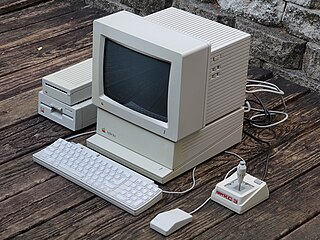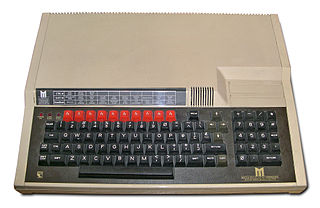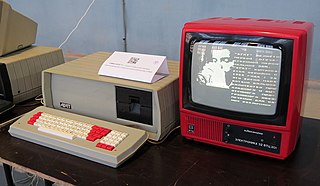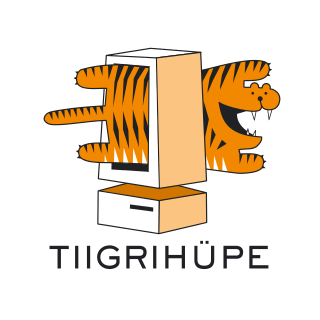
The Acorn Electron was introduced as a lower-cost alternative to the BBC Micro educational/home computer, also developed by Acorn Computers, to provide many of the features of that more expensive machine at a price more competitive with that of the ZX Spectrum. It has 32 kilobytes of RAM, and its ROM includes BBC BASIC II together with the operating system. Announced in 1982 for a possible release the same year, it was eventually introduced on 25 August 1983 priced at £199.

Apple II is a series of microcomputers manufactured by Apple Computer, Inc. from 1977 to 1993. The first Apple II model, that gave the series its name, was designed by Steve Wozniak, and was first sold on June 10, 1977. Its success led to it being followed by the Apple II Plus, Apple IIe, Apple IIc, and Apple IIc Plus, with the 1983 IIe being the most popular. The name is trademarked with square brackets as Apple ][, then, beginning with the IIe, as Apple //.

Atari ST is a line of personal computers from Atari Corporation and the successor to the company's 8-bit home computers. The initial model, the Atari 520ST, had limited release in April–June 1985, and was widely available in July. It was the first personal computer with a bitmapped color graphical user interface, using a version of Digital Research's GEM interface / operating system from February 1985. The Atari 1040ST, released in 1986 with 1 MB of memory, was the first home computer with a cost per kilobyte of RAM under US$1/KB.

The Tandy 1000 was the first in a series of IBM PC compatible home computers produced by the Tandy Corporation, sold through its Radio Shack and Radio Shack Computer Center stores. Introduced in 1984, the Tandy 1000 line was designed to offer affordable yet capable systems for home computing and education. Tandy-specific features, such as enhanced graphics, sound, and a built-in joystick port, made the computers particularly attractive for home use.

The Apple IIGS is a 16-bit personal computer produced by Apple Computer beginning in September 1986. It is the fifth and most powerful model of the Apple II family. The "GS" in the name stands for "Graphics and Sound", referring to its enhanced multimedia hardware, especially the state-of-the-art audio. It is compatible with earlier Apple II models, and Apple initially sold a kit for converting an Apple IIe into a IIGS. The system is a radical departure otherwise, with a WDC 65C816 microprocessor, 256 KB of random-access memory at launch expandable to 8 MB, resolution and color similar to the Amiga and Atari ST, and a 32 channel Ensoniq wavetable synthesis chip. Bundled with a mouse, it is the first computer from Apple with a color graphical user interface and the Apple Desktop Bus interface for keyboards, mice, and other input devices.

The Apple IIc is a personal computer introduced by Apple Inc. shortly after the launch of the original Macintosh in 1984. It is essentially a compact and portable version of the Apple IIe. The IIc has a built-in floppy disk drive and a keyboard, and was often sold with its matching monitor. The c in the name stands for compact, referring to the fact it is a complete Apple II setup in a smaller notebook-sized housing. It is compatible with a wide range of Apple II software and peripherals.

The ImageWriter is a product line of dot matrix printers formerly manufactured by Apple Computer, Inc., and designed then to be compatible with their entire line of computers. There were three different models introduced over time, which were popular among Apple II and Mac owners.
The Didaktik was a series of 8-bit home computers based on the clones of Intel 8080 and Zilog Z80 processors produced by Didaktik in Skalica, in the former Czechoslovakia.

The BBC Master is a home computer released by Acorn Computers in early 1986. It was designed and built for the British Broadcasting Corporation (BBC) and was the successor to the BBC Micro Model B. The Master 128 remained in production until 1993.
The CST Thor series of personal computers are Sinclair QL-compatible systems designed and produced by Cambridge Systems Technology during the late 1980s.

The Commodore 64 home computer used various external peripherals. Due to the backwards compatibility of the Commodore 128, most peripherals would also work on that system. There is also some compatibility with the VIC-20 and Commodore PET.

The Agat was a series of 8-bit computers produced in the Soviet Union. It used the same MOS Technology 6502 microprocessor as Apple II and BBC Micro, amongst many others. Commissioned by the USSR Ministry of Radio, for many years it was a popular microcomputer in Soviet schools.

Tiigrihüpe was a project undertaken by the Republic of Estonia to heavily invest in development and expansion of computer and network infrastructure in Estonia, with a particular emphasis on education. The project was first proposed in 1996 by Toomas Hendrik Ilves, then ambassador of Estonia to United States and later President of Estonia, and Jaak Aaviksoo, then minister of Education. The project was announced by Lennart Meri, the President of Estonia, on 21 February 1996. Funds for the foundation of Tiigrihüpe were first allocated in national budget of 1997.

The history of the personal computer as a mass-market consumer electronic device began with the microcomputer revolution of the 1970s. A personal computer is one intended for interactive individual use, as opposed to a mainframe computer where the end user's requests are filtered through operating staff, or a time-sharing system in which one large processor is shared by many individuals. After the development of the microprocessor, individual personal computers were low enough in cost that they eventually became affordable consumer goods. Early personal computers – generally called microcomputers – were sold often in electronic kit form and in limited numbers, and were of interest mostly to hobbyists and technicians.

Mera–Elzab Meritum – a family of Polish personal computers based on TRS-80 Model I with BASIC Level II. Manufactured in the 1980s by Mera–Elzab in cooperation with ITM company.

The history of laptops describes the efforts, begun in the 1970s, to build small, portable personal computers that combine the components, inputs, outputs and capabilities of a desktop computer in a small chassis.

Poisk is an IBM-compatible computer built by KPO Electronmash in Kyiv, Ukrainian SSR during the Soviet era. It is based on the K1810VM88 microprocessor, a clone of the Intel 8088. Developed since 1987 and released in 1989, it was the most common IBM-compatible computer in the Soviet Union.

The Sharp PC-7000 is a luggable portable computer released by Sharp Electronics in 1985. The PC-7000 was Sharp's second entry into the IBM PC-compatible portable computer market, their first being the PC-5000.
The Eazy PC is an all-in-one IBM PC compatible computer manufactured by Zenith Data Systems (ZDS) starting in 1987. This small-form-factor XT-compatible system has some distinctive features, such as using an NEC V40 CPU. The Eazy PC was designed to be a simple, cost-effective computer for the home. This was a departure for ZDS, who had historically avoided the retail consumer market to focus on customers such as businesses, universities, and government agencies.



















